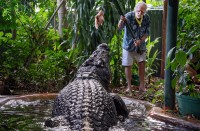A footprint measuring over a meter wide that was made by a meat-eating predator some 80 million years ago has been discovered in Bolivia, one of the largest of its kind ever found.
The print, which measures 1.2 meters (1.3 yards) across, probably belonged to the abelisaurus, a biped dinosaur that once roamed South America, said Argentine palaeontologist Sebastian Apesteguia, who is studying the find.
The print was found some 64 kilometres (40 miles) outside the city of Sucre in central Bolivia by a tourist guide earlier this month. The soft clay area near Sucre is well known for dinosaur tracks, and skeletal remains of the abelisaurus have also previously been found in the region.
“We found a footprint of a carnivorous, huge, colossal dinosaur, something that was completely unexpected and is special because we are talking about a trace that apparently belongs to an abelisaurus,” Apesteguia said.
The palaeontologist added that the dinosaur is believed to have lived during the third, and last, period of the Mesozoic Era.
“The abelisaurus were the great carnivores of the end of the Cretaceous period, in other words, the last part of the era of dinosaurs in the southern hemisphere. The northern hemisphere had other great carnivores but, in the south, we had the abelisaurus and footprints this large of abelisaurus have never been reported. Their normal size was around 9 meters, large animals, however, the footprints we found (were for an animal that) easily exceed ten or even 12 meters.”
Apesteguia said he found it in Kinsa Saruska in the syncline of Maragua, some 60 km of Sucre, Bolivia, the constitutional capital of the country. Sucre has a high elevation of 2,810 meters (9,214 ft) that gives the area a mild, cool climate and thin air.
The area where he found the footprints, the Cal Orcko cliff, contains thousands of dinosaur footprints discovered on the site of a local cement company. The site is a tourist attraction that includes a dinosaur-themed park, the Parque Cretacico.
(c) Copyright Thomson Reuters 2016








